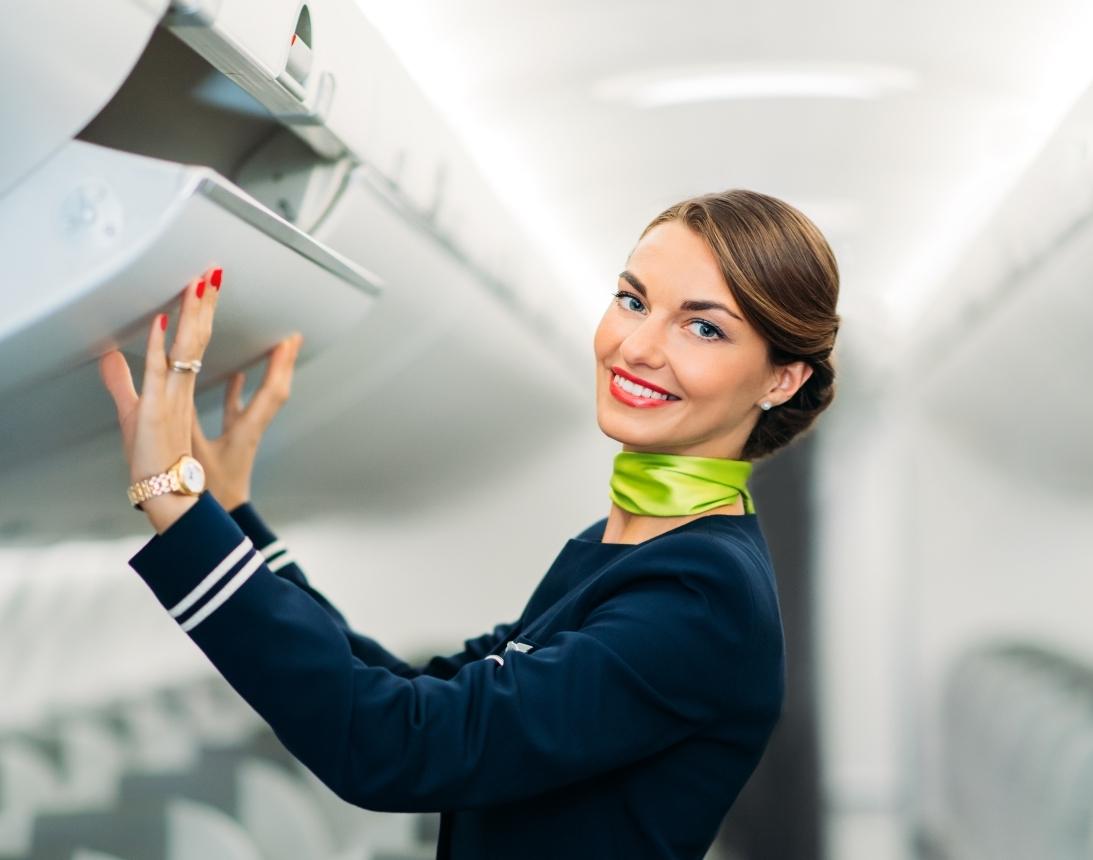
Everyone travelling by air appreciates a comfortable flight aided by amenities such as inflight entertainment and connectivity and a decent amount of personal space. And there are plenty of premium cabins on aircraft to provide just that.
For a small group of people though, namely flight attendants, a comfortable cabin is also their ‘office’. And they need it to be just as comfortable for them to do their job as it is for customers to travel.
Crossover narrowbody jets, such as the Embraer E-Jet E2 and Airbus A220 families, have some of the most modern cabins among the available aircraft types. The interiors for both families were clean sheet designs and much in their development was discussed in airline focus groups to achieve the final product.
As with any workplace, a positive overall feeling can elevate the mood and make staff more productive, as Tanja Banghard, head of cabin crew at Helvetic Airways confirms. The airline operates eight E190-E2s and four E195-E2s as well as flying four E190-E1s on behalf of Swiss.
“Our cabin crews really appreciate working in a new aircraft – it's like driving a new car. In addition, the E2 is very well accepted by our guests, especially the pleasantly bright ambience and the red carpet make them enter the aircraft with a good feeling. The feedback to the crews is correspondingly positive – this motivates the employees and makes them proud,” Banghard reports.
“The various working areas in the cabin have also been designed according to the wishes and requirements of the cabin crews. These include, for example, the galley layout and the latest generation of stove, coffee machine and water boiler. The large overhead bins simplify the boarding process and make every day work much easier for the crew,” she adds. “Furthermore, the movable class dividers help to adapt the cabin configuration to the corresponding situation on board in just a few steps. All these amenities enable us to offer our passengers a premium service in a pleasant and efficient working environment for the crews, even on short-haul routes and in the charter sector.”
Gatis Stanga, cabin standard specialist at airBaltic, reports similar feelings about the airline’s A220s. “Since the launch of the operations with Airbus A220-300 back in 2016, we have received an overwhelmingly positive feedback from both our passengers and team. Our cabin crew love working on the aircraft type as the environment is new and modern with latest available technology,” he remarks.
Often what makes a difference for the crew is being able to influence the cabin design and the buyer-furnished equipment (BFE) they need for their tasks. Stanga recognises the advantage. “We used the opportunity along the way to provide input for our cabin layout as necessary and it was really useful. One of the examples where we shared our input was the layout of galley,” he confirms.
Helvetic too went for its own choices rather than the full range of supplier-furnished equipment (SFE). According to Banghard, non-standard equipment in the E2s, installed based on Helvetic Airways input includes: cabin temperature control (dual zone for better temperature regulation in the cabin); USB ports on the passenger seats (two ports per double seat) for charging mobile devices; double flight attendant seat for training purposes; lavatory with access for passengers with reduced mobility (PRMs); movable class dividers with aisle curtain; a third oxygen mask per double seat; and the airline’s own selection of mood lighting.
Banghard also highlights the elements on the E2s which Helvetic’s cabin crew specifically believe helps them do their jobs more efficiently, when compared with the previous types the airline operated. “At first glance, it is noticeable that the light grey cabin is much brighter than in the E1. It looks friendly and modern – the large windows also play an important role here,” she observes.
“The new mood lights on the side of the cabin can be varied in colour, which has a valuable effect and contributes to a pleasant atmosphere. Since there are two temperature zones in the E2, the cabin temperature can be regulated more precisely and quickly. In addition, it is much quieter in the cabin than in the E1, which is particularly noticeable in the rear part of the aircraft.
“The overhead bins have become significantly larger,” she continues. “This is an enormous relief in a regional aircraft, as passengers often travel with hand luggage only. Despite their size, they are also very pleasant to handle. The doors of the E2 aircraft are also easier to operate – both the boarding doors and the overwing emergency exits.
“Technologically, too, a lot has changed,” Banghard says. “Today’s CMS (cabin management system) of the E2 is state of the art and offers much more information – from the flight time to the display of who pressed the service button, how long ago. In addition, all seats in the E2s have USB ports for charging mobile devices such as mobile phones or tablets, which is much appreciated by our passengers.”
Stanga describes airBaltic as a proud ambassador of the Airbus A220-300 and declares, “There are several items in the aircraft, which make the duties of our cabin crew easier.
“First are the Customer Service Displays, special screens above each passenger row where a moving map is shown during flight. The display means that during the flight, the passengers can easily see all flight information there and do not need to ask this to the cabin crew. Before the departure, the display is used to show the safety briefing as it is clearly visible to all passengers,” Stanga explains.
“Our Mood lighting gives us the option to differentiate passenger feelings with light during different stages of flight. For example, during night landings, it gives an opportunity for passengers to slowly wake up with a sort of a sunrise effect or, for example, give a festive feeling with Christmas light scenario,” he adds.
“Finally, the Cabin Management System enables crew to monitor cabin temperature, door status, switch on the fasten seat belt sign in case of turbulence, and inform the Operational Centre via the ACARS system in case there is some necessity to pass some information,” Stanga relates.
The front-line staff at airlines need to deliver top quality customer service to keep customers and a positive environment in which to work aids that goal enormously. The airlines’ collaborations with crossover narrowbody jet OEMs are thus producing a win–win for passengers and cabin crew alike.





